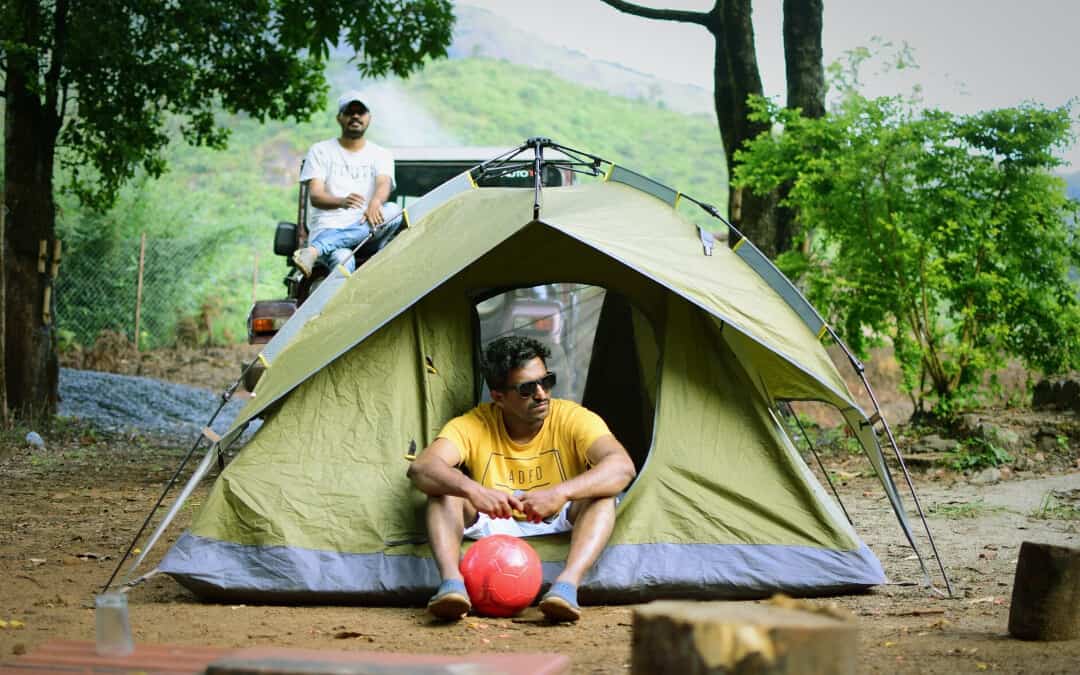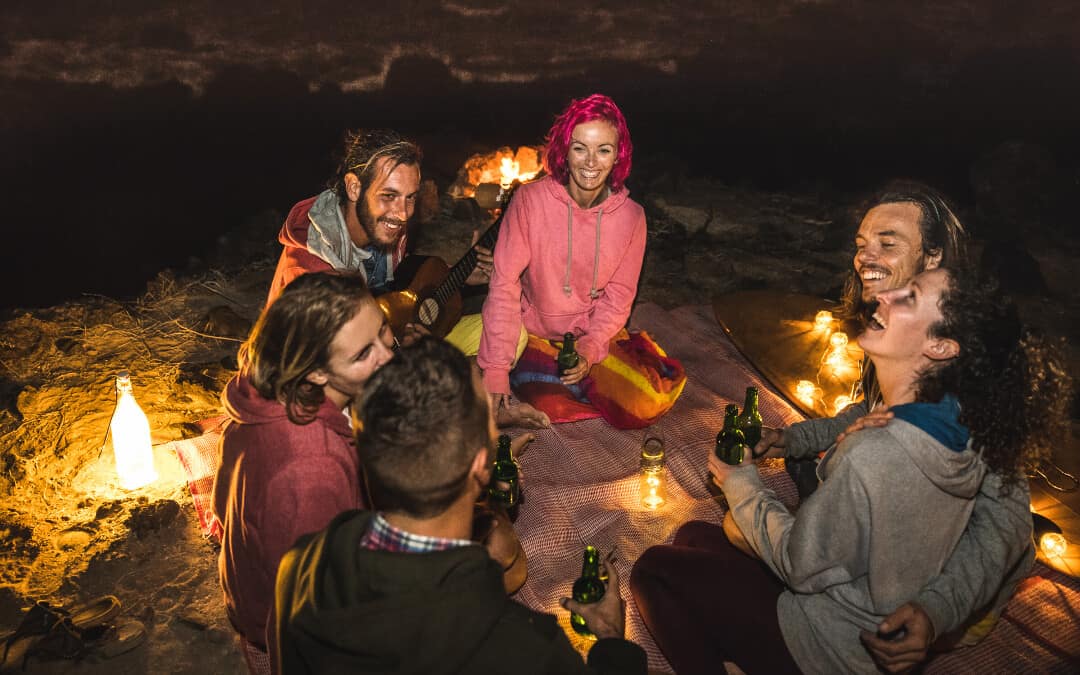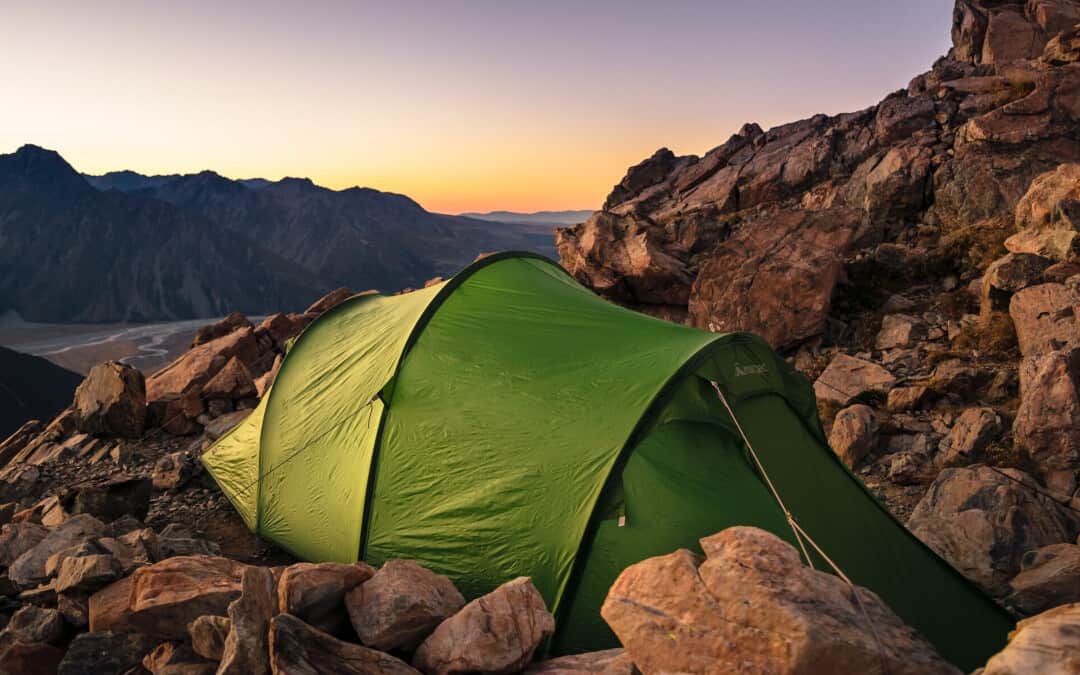Tent heaters & air conditioners can help get your tent to a comfortable level, and it’s highly recommended you invest in a temperature control for your tent to make your camping experience more comfortable and enjoyable.
However, these devices are only part of the puzzle, and should be used in moderation. It’s important to plan ahead and bring a few key tools to keep you warm or cool (depending on the weather you’re anticipating for your upcoming outing). It’s not just about keeping your tent at the right temperature–it’s about keeping yourself at the right temperature.
Cold Camping Tips – How to Stay Warm in Your Tent
Camping Tent Heaters
Heaters are one of the easiest ways to maximize your comfort on a cold camping trip, if you have access to an electric hookup (EHU). If the campsite you’re going to doesn’t, skip this section and go to Other Camping Gear to Keep You Warm.
One of the most common questions asked is: Are camping tent heaters safe? The answer is yes–when used responsibly. No matter what type of heater you choose (we’ll look at several popular types below), you should never leave it on unattended, and don’t leave it on while you sleep.
Instead, these heaters are best used to warm the tent to a comfortable level before turning in for the night, and to get the tent nice and toasty right after waking up.
A note about placement: be sure you keep your tent heater off the ground to prevent it from getting damp or wet in case of inclement weather. Be sure to keep it away from the sides of your tent–lots of tent fabrics are surprisingly flammable.
Electric Fan Heaters
An electric fan heater is a popular choice for campers. They heat tents relatively quickly and they’re light.
Pros:
Fast(er) heating
Portable & light
Fairly cheap
Cons:
Kind of loud
Leaves air feeling dry
A main complaint about electric fan heaters is that they can be noisier than alternative solutions. However, if you don’t plan on sleeping with it on (you shouldn’t), noise shouldn’t be much of an issue. Another common issue is they can leave air feeling a bit dry and stuffy – however, some people consider this a bonus as damp air in cold weather isn’t the most comfortable setting.
Electric Radiators
Using an electric radiator to warm you tent can be awesome, but if you plan on packing up and moving camp on foot at any time during your trip, look for an alternative heating solution.
Pros
Quiet heating
Stays warm after turned off
Doesn’t dry out the air inside the tent
Cons
Not portable, heavy
Slower to heat a tent than alternatives (in some cases)
Electric radiators really take camping to a whole new level, but they’re not without their drawbacks. For starters, they usually weigh a ton and aren’t conducive when it comes to packing up and hiking to a different campsite.
Additionally, they take a while to heat up – much longer than the alternative heating options listed here. Not a huge deal, just don’t expect to turn it on and be flooded with warmth. Fortunately, some electric radiators come with a fan that pushes hot air quicker while the radiator heats up.
With that being said, radiators are much more quiet than electric fan heaters, so if you’re looking to enjoy the sounds of nature in all their glory, this may be a better option. They also stay warm for much longer after turning them off, which is ideal for staying warmer for longer as you drift off to sleep.
Electric Halogen Tent Heaters
If you’re at a campsite where the electric hookups are lower-powered (a fairly common scenario), an electric halogen tent heater is a great choice.
Note: Free-standing halogen heaters can be a fire risk, so it’s better to steer clear of them and opt for a hanging one instead.
Pros
Quiet, fast heating
Lightweight & portable
Glows nicely, which can help you see in the tent at night
Cons
Standing halogen heaters can cause fires
Hanging halogen heaters can get in the way
Doesn’t heat a large area well
Electric Halogen Tent Heaters put out a surprising amount of heat for coming in such a small package, but if you have a big tent the heat may not reach the corners as well as you’d like.
With a hanging heater, there’s a danger of walking face-first into it if you aren’t paying attention, so it’s a good idea to put something underneath it to remind you it’s there (a table, for example — if your tent is big enough). If you’re unable to do so, just try to be mindful it’s there.
It shouldn’t be an issue, but the heater will be close to the tent ceiling, so it’s a good idea to keep an eye on the fabric above the heater to ensure it doesn’t get too warm. It’s up to you as to whether or not you keep it running all night, but it’s probably a better idea not to.
Wood Burning Stoves
Pros
Don’t need an electric hookup
Efficient heating
Keeps the tent nice and toasty after use
Cons
Your tent needs to be built for a wood burning stove
Usually not very portable.
In order to consider using a wood burning stove to warm your tent, you have to have a tent that is compatible with it–most tents on the market aren’t. You’ll need a specialty tent that has a flue. If you have a fire-retardant canvas tent, you can make your own flue, but it’s a better idea to purchase one that has one included.
You’ll need to invest in a fire-retardant, heat resistant mat unless you can remove the flooring of the tent. For your safety, you should also consider investing in a carbon monoxide alarm to ensure there’s no build-up and the flue is functioning properly.
They’re also usually not very portable (bulky & heavy), but there are a few nice models that are smaller and work well, which we’ll look at below.
With that being said, wood burning stoves are fantastic because they don’t require electricity, unlike the other heating options–so you’re not limited to finding campsites with EHUs.
Portable Gas Heaters
Steer clear of portable gas heaters at all costs. They’re way too risky to use–not because of their chances of catching fire (which has been reduced as technology has improved over the years)–but because they can pump out carbon monoxide.
These types of heaters should never be used in an enclosed space, especially a space as small as a tent.
Other Camping Gear to Keep You Warm
Heaters are great when you can utilize one (access to electricity, room to bring one with you, etc.), but there’s plenty of other equipment that you can use alongside a heater, or in place of a heater when bringing one isn’t possible.
Long Johns (aka Thermal Underwear)
Long Johns may not be the the most stylish clothing ever invented, but you’ll be glad you brought them when you’re spending a night outdoors in the cold. They’re usually made from cotton, a cotton-polyester blend, flannel, or wool, and they work incredibly well for how light-weight they are.
When looking for a solid pair of thermal underwear, try to find sets that include polyester or wool. Polyester helps with wicking away moisture because the fabric draws moisture from your skin to the exterior of the Long Johns, which allows the water to evaporate quicker. Wool is an incredible insulator and can keep you warm even when wet.
Hot Water Bottles
Bring a hot water bottle or two to throw in your sleeping bag to warm it up and keep it nice and toasty. They come in handy, even in moderate weather (60 degrees or so), and don’t take up much room. Of course, you’ll need a way to heat water to utilize it, so be sure to bring a kettle & stove.
Sleeping Bag Liners
Tent Carpets or Rugs
Once you’ve camped with a tent carpet or rug, you’ll wonder how you ever got by without one. You won’t believe it until you try it, but a rug instantly upgrades a tent to make it feel more like a home. They can be a bit pricey, but they’re well worth the investment; or you can opt to use an alternative option–check out our “Should I Buy a Tent Carpet?” post for more information.
Of course, if you’re backpacking, leave the tent carpet at home–they’re bulky and heavy, and as awesome as they are, they aren’t worth trying to haul around the extra weight.
Tips to Keep in Mind to Stay Warmer
Bring a Smaller Tent
The more space you have in your tent, the harder it is to get warm and keep it that way. Natural body heat can be useful, but only if you’re in a tent that’s appropriately sized for you and/or your group. Having more space is nice, but keeping warm on a cold night is generally the better way to go.
Additionally, if possible, bring a tent made of a thicker material, such as canvas – as they’re better at retaining heat.
Warm Up Before Calling it a Night
It’s hard to get warmed back up once you lay down, so if you’re feeling a chill the best idea is to try and bring your body temperature up. There are several ways to do this: enjoy some nice hot tea (or hot chocolate, etc. – whatever you’re feeling), do a quick workout (jog in place, do some jumping jacks, etc.), or huddle by the fire before you put it out for the night.
Hot Camping Tips – How to Stay Cool in Your Tent
Camping Tent Air Conditioners
Air conditioners are one of the most efficient ways to stay cool on a camping trip, if you have access to an electric hookup (EHU). If the campsite you’re going to doesn’t, skip this section and go to Other Camping Gear to Keep You Cool.
One of the most common questions asked is: Are camping tent air conditioners safe? The answer is yes–there shouldn’t be any issue with running a nicely built modern tent air conditioning unit for any length of time.
To be safe, it’s probably a good idea to shut it off when you’re out exploring (since tents are small compared to a house, they don’t take long to cool down when you get back), and keep the unit off the ground and protected from the rain.
Camping Tent Fans
Bring a bigger tent.
Other Camping Gear to Keep You Cool
Tips to Keep in Mind to Stay Cooler




0 Comments